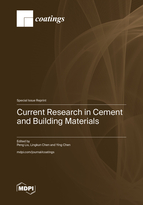Current Research in Cement and Building Materials
A special issue of Coatings (ISSN 2079-6412). This special issue belongs to the section "Surface Characterization, Deposition and Modification".
Deadline for manuscript submissions: closed (10 September 2023) | Viewed by 40787
Special Issue Editors
Interests: cementitious materials; concrete; durability; coating materials; building materials; damage
Interests: engineering; mechanical; bridge
Special Issues, Collections and Topics in MDPI journals
Interests: cementitious materials; concrete structures; structural engineering; coating materials; synthesis and preparation nano materials; concrete durability
Special Issue Information
Dear Colleagues,
Building materials are the main components of current architecture, which directly determines the quality and service life of the buildings. The field of current research in cement and building materials, with all its traditionalism and multidisciplinarity, also profited from this development. However, the specific features of this field have led to a considerable scattering of literary sources and a lack of mutual information between all relevant subjects. Moreover, the latest research achievements of cement and building materials are not summarized.
This Special Issue should help to overcome these problems. It provides an opportunity to create a compendium of novel cement and building materials, which will not only boost further scientific progress but also provide restorers and artists with a useful literary overview. It is focused on cement and building materials, publishing the most important results from different regions of the world.
I cordially invite you to submit your contribution to this issue, whose topics include but are not limited to the following:
- Cement and building materials;
- Design and preparation of concrete;
- Cementitious capillary crystalline waterproofing materials;
- Special cement including preparation, applications, and implementation issues;
- Structural health monitoring;
- Concrete structures;
- Inorganic non-metal material;
- Structural health monitoring;
- Durability of concrete structures.
Dr. Peng Liu
Dr. Lingkun Chen
Dr. Ying Chen
Guest Editors
Manuscript Submission Information
Manuscripts should be submitted online at www.mdpi.com by registering and logging in to this website. Once you are registered, click here to go to the submission form. Manuscripts can be submitted until the deadline. All submissions that pass pre-check are peer-reviewed. Accepted papers will be published continuously in the journal (as soon as accepted) and will be listed together on the special issue website. Research articles, review articles as well as short communications are invited. For planned papers, a title and short abstract (about 100 words) can be sent to the Editorial Office for announcement on this website.
Submitted manuscripts should not have been published previously, nor be under consideration for publication elsewhere (except conference proceedings papers). All manuscripts are thoroughly refereed through a single-blind peer-review process. A guide for authors and other relevant information for submission of manuscripts is available on the Instructions for Authors page. Coatings is an international peer-reviewed open access monthly journal published by MDPI.
Please visit the Instructions for Authors page before submitting a manuscript. The Article Processing Charge (APC) for publication in this open access journal is 2600 CHF (Swiss Francs). Submitted papers should be well formatted and use good English. Authors may use MDPI's English editing service prior to publication or during author revisions.
Keywords
- cement
- concrete
- smart materials
- advanced materials
- structural health monitoring
- intelligent system
- durability
- inorganic non-metal material








